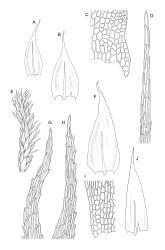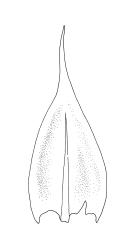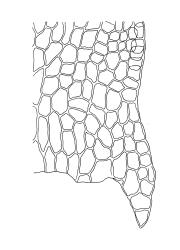- ≡ Hypnum albicans Hedw., Sp. Musc. Frond. 251 (1801)
- ≡ Chamberlainia albicans (Hedw.) H.Rob., Bryologist 65: 112 (1962)
Plants medium-sized, often very slender, soft, yellow- or white-green, usually forming dense turves. Stems ascendant, less often creeping, irregularly branched, usually slender and elongate, pale green, to at least 90 mm long (commonly less than 45 mm), terete, in cross-section with a central strand and several layers of thick-walled cortical cells, very sparsely beset below with yellow-brown smooth rhizoids (in fascicles on abaxial side of leaf bases). Branches variable, 5–20(–35) mm long, terete or with leaves ± secund. Stem leaves imbricate and erect, ovate-lanceolate, slenderly acuminate, plicate both dry and moist, with margins plane throughout or weakly reflexed below, strongly concave, narrowly decurrent, entire or weakly denticulate near apex, (1.8–)2.0–2.6(–2.8) × c. 0.9 mm. Branch leaves smaller, c. (0.9–)1.3–1.8 mm, not decurrent, often somewhat secund, weakly plicate, with a smaller alar group. Costa (of stem leaves) c. 30–45 wide (⅓ above base), extending ½–⅔ the length of the leaf and ending below acumen base, lacking a terminal abaxial spine. Upper laminal cells (of stem leaves) smooth, firm-walled, linear, 42–60(–75) × 6–8 µm, gradually becoming shorter and broader near insertion; alar cells (of stem leaves) quadrate, short-rectangular, or oblate, firm-walled, forming a large but weakly differentiated group extending into the decurrency, c. 8–15 cells up the margin (excluding the decurrency), and reaching c. ⅓ to the base of the costa.
Dioicous. Perichaetial leaves slenderly lanceolate-acuminate, not or very weakly costate, ± secund. Perigonia gemmiform, scattered on stems, with bracts broadly ovate-lanceolate, weakly costate, widely spreading at apices, with filiform, 5–6-celled paraphyses and c. 12 antheridia. Setae 8–10 mm in N.Z. material, smooth, flexuose, mostly weakly dextrorse above, red-brown; capsules inclined, asymmetric, oblong-ovoid, c. 1.5 mm (excluding operculum), red-brown; exothecial cells oblate to shortly rectangular. Operculum bluntly conic. Exostome teeth and endostome not clearly seen in N.Z. material. Spores c. 12–14 µm.
Crum & Anderson 1981, fig. 509; Hedenäs 2002, fig. 2 d–e; Meagher & Fuhrer 2003, pp. 50–51; Smith 2004, fig. 273, 1–5.
The slender, terete habit and its frequent presence among mown grasses are often sufficient to differentiate this species from its congeners. Slenderly acuminate leaves with entire margins and a large group of decurrent quadrate alar cells are microscopic features providing distinction. Smith (2004, p. 820) succinctly describes this species in Britain as “readily recognized in the field by the pale silky patches and string-like shoots with imbricate plicate leaves”.
Confusion can occur between the present species and some forms of B. salebrosum. The present species is dioicous and rarely fruiting, while B. salebrosum is autoicous and often fruiting. Brachythecium albicans is a less branched plant with distinctly terete stems and branches, entire leaves, and a proportionally larger alar group of firm-walled and quadrate, shortly-rectangular or oblate cells. The decurrency usually coheres to the leaf base when leaves are stripped from the stem, in contrast to B. salebrosum.
Confusion sometimes also occurs with Ischyrodon lepturus (Fabroniaceae), which is a coastal species in N.Z. In the non-coastal B. albicans the plants are more ascendant, the stem leaves are clearly decurrent, and the alar cells extend only c. ⅓ to the base of the costa (while in I. lepturus the alar cells extend over the adaxial surface of the costa base). Other differences are detailed under I. lepturus.
NI: N Auckland, S Auckland, Gisborne (Waioeka Gorge), Hawke’s Bay, Taranaki, Wellington; SI: Nelson, Marlborough, Canterbury, Otago, Southland.
Adventive. Tasmania*, mainland Australia*. Widespread in the northern hemisphere, including Europe* and North America*.
A very weedy species occurring in a wide range of modified habitats. Very often among grasses, often in lawns (either roughly or closely mown), less often in native scrub or open areas in forests, especially at road or track margins; occurring in both dry and moist situations. Sometimes occurring on or adjacent to concrete or even asphalt, in dune slacks, and waste areas. Rarely on tree (Sophora, Salix) bases and even waterlogged peat. Ranging from near sea level (Mayor I., S. Auckland L.D.) to c. 1100 m (Mt Taranaki, Taranaki L.D.) on the North I. and from sea level (Christchurch) to at least 950 m (near Beaumont in Blue Mountains, Otago L.D.) on the South I. Breutelia affinis, Ceratodon purpureus, Eurhynchium praelongum, Pseudoscleropodium purum, Syntrichia antarctica, Thuidiopsis furfurosa, and Triquetrella triquetra are frequently associated moss species.
An early, and possibly the first N.Z., collection of this species was made by V.D. Zotov in 1931 at Palmerston North (Wellington L.D.). The species is nearly always sterile in N.Z. and the only fruiting N.Z. collection appears to be from Wanaka (Otago L.D., P. Beveridge AT-28, WELT M036343).








